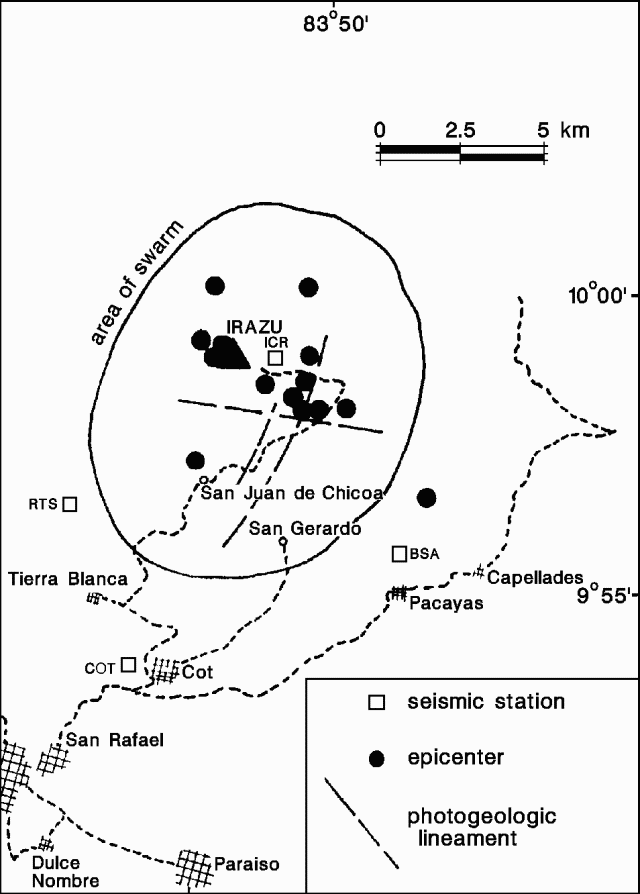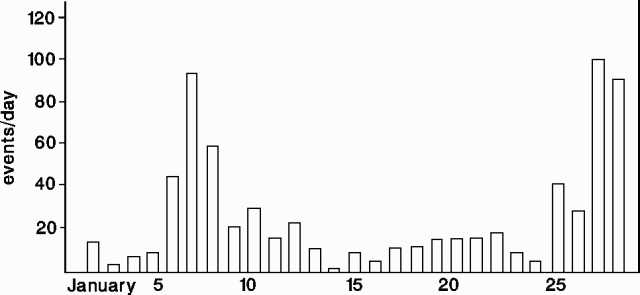Report on Irazu (Costa Rica) — January 1991
Bulletin of the Global Volcanism Network, vol. 16, no. 1 (January 1991)
Managing Editor: Lindsay McClelland.
Irazu (Costa Rica) Nearby seismic swarm apparently tectonic; surface activity unchanged
Please cite this report as:
Global Volcanism Program, 1991. Report on Irazu (Costa Rica) (McClelland, L., ed.). Bulletin of the Global Volcanism Network, 16:1. Smithsonian Institution. https://doi.org/10.5479/si.GVP.BGVN199101-345060
Irazu
Costa Rica
9.979°N, 83.852°W; summit elev. 3436 m
All times are local (unless otherwise noted)
A seismic swarm, centered between San Juan de Chicuá and the summit (figure 1), began on 2 January and continued through the end of the month. Two peaks in swarm activity occurred, the first on 7 January when 95 events were recorded, and the second on 27 January with 103 events (figure 2); 700 were recorded during the month. Seismicity increased towards the end of January, with maximum magnitudes of 4.0 (table 2) and intensities of MM III-IV. Several of the shocks were felt by area residents.
 |
Figure 1. Epicenters of earthquakes recorded during the January 1991 seismic swarm at Irazú. Courtesy of Gerardo Soto. |
Table 2. Strongest events during the earthquake swarm at Irazú, January 1991.
| Date | Time | Magnitude |
| 07 Jan 1991 | 1011 | 2.1 |
| 07 Jan 1991 | 1013 | 2.1 |
| 07 Jan 1991 | 1234 | 2.5 |
| 07 Jan 1991 | 1352 | 2.7 |
| 08 Jan 1991 | 0407 | 3.3 |
| 13 Jan 1991 | 1017 | 3.5 |
| 16 Jan 1991 | 0708 | 3.8 |
| 16 Jan 1991 | 0748 | 2.0 |
| 27 Jan 1991 | 0117 | 3.2 |
| 27 Jan 1991 | 0258 | 3.3 |
| 27 Jan 1991 | 1049 | 3.4 |
| 27 Jan 1991 | 1109 | 3.6 |
| 27 Jan 1991 | 2109 | 3.8 |
Seismologists determined that the earthquakes were tectonic in origin and occurred at very shallow depth. No morphologic changes were noted at the volcano and fumarolic activity appeared to be similar to previous years. Seismic swarms had previously been recorded at Irazú in 1982 and 1987, although normal seismic activity is very low. Scientists noted that the shocks may be related to a fault SSE of the volcano, perhaps activated by the major earthquake [M 5.7] that occurred near Puriscal [50 km WSW] on 22 December.
Geological Summary. The massive Irazú volcano in Costa Rica, immediately E of the capital city of San José, covers an area of 500 km2 and is vegetated to within a few hundred meters of its broad summit crater complex. At least 10 satellitic cones are located on its S flank. No lava effusion is known since the eruption of the Cervantes lava flows from S-flank vents about 14,000 years ago, and all known Holocene eruptions have been explosive. The focus of eruptions at the summit crater complex has migrated to the W towards the main crater, which contains a small lake. The first well-documented eruption occurred in 1723, and frequent explosive eruptions have occurred since. Ashfall from the last major eruption during 1963-65 caused significant disruption to San José and surrounding areas. Phreatic activity reported in 1994 may have been a landslide event from the fumarolic area on the NW summit (Fallas et al., 2018).
Information Contacts: G. Soto and R. Barquero, ICE; Mario Fernández and Wilfredo Rojas, Escuela Centroamericana de Geología, Univ de Costa Rica.


